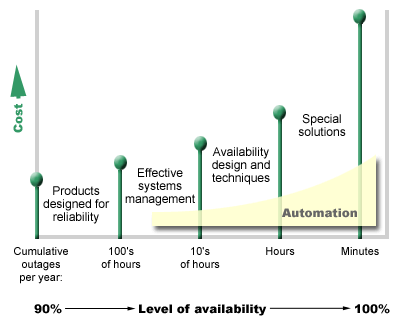 After understanding availability at a basic level,
it important to assess your individual availability needs. Higher availability
is more costly than a lower level availability. You must balance your needs
and services with the overall cost of implementing and maintaining these availability
solutions.
After understanding availability at a basic level,
it important to assess your individual availability needs. Higher availability
is more costly than a lower level availability. You must balance your needs
and services with the overall cost of implementing and maintaining these availability
solutions.
You want to be sure that you have analyzed your business needs thoroughly in order to decide what level of availability you can afford to maintain. To decide what level of availability you need, consider the following questions:
Do you have any applications that require 100% availability?
In most cases, you can achieve a high level of availability by implementing sound processes and systems management practices. The closer you need to be to continuous availability, the more of an investment you have to make. Before you make that kind of investment, you should be sure that you require that level of availability. The following figure shows how different techniques can improve availability, but can increase the price you have to pay for it.

 If your requirements for levels of availability increase,
you may want to consider multiple system availability solutions, such as clusters.
If your requirements for levels of availability increase,
you may want to consider multiple system availability solutions, such as clusters.
How much downtime is acceptable to you?
It may help you to know what amount of downtime each level of availability represents. The following table shows the amount of downtime you should expect for different levels of availability.
| Level of availability | Downtime per year |
|---|---|
| 90% | 36.5 days |
| 95% | 18.25 days |
| 99% | 3.65 days |
| 99.9% | 8.76 hours |
 99.99% 99.99% |
 50 minutes 50 minutes |
 99.999% 99.999% |
 5 minutes 5 minutes |
Along with knowing how much downtime is acceptable to you, you need to consider how that downtime may occur. For example, you may think that 99% availability is acceptable if the downtime is a series of shorter outages that are distributed over the course of a year. But, you may think differently about 99% availability if the downtime were actually a single outage that lasts 3 days.
 You also need to consider when
a downtime is acceptable and when it is not. For example, your average annual
downtime goal per year might be 9 hours. If that downtime were to occur during
critical business hours, it could have an adverse affect on the bottom line
revenue for your company.
You also need to consider when
a downtime is acceptable and when it is not. For example, your average annual
downtime goal per year might be 9 hours. If that downtime were to occur during
critical business hours, it could have an adverse affect on the bottom line
revenue for your company.
What level of access do your customers need to your business?
 It used to be that customers and business partners accessed your
business from 9 a.m. to 5 p.m., so it was realistic to expect that your system
only had to be available during those hours. However, the Internet and a diverse
global marketplace have changed that expectation; customers and business associates
may expect to have access to your company's data at any time of the day or
night. Your working hours may be hours or even days different from your global
business partner or customer. You have to determine what your customer expectations
are, and what is realistic with regard to those expectations, as you determine
what level of availability you will maintain.
It used to be that customers and business partners accessed your
business from 9 a.m. to 5 p.m., so it was realistic to expect that your system
only had to be available during those hours. However, the Internet and a diverse
global marketplace have changed that expectation; customers and business associates
may expect to have access to your company's data at any time of the day or
night. Your working hours may be hours or even days different from your global
business partner or customer. You have to determine what your customer expectations
are, and what is realistic with regard to those expectations, as you determine
what level of availability you will maintain.